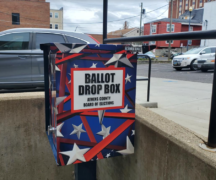By JAN LARSON McLAUGHLIN
BG Independent News
Proposed voting law changes in Ohio will make it easier to vote and harder to cheat, according to Secretary of State Frank LaRose.
Standing in the Wood County Courthouse atrium – where lines of voters stood six months ago to cast early ballots – LaRose said the election process faced daunting challenges last year.
“It’s never been harder to run elections as it was last year,” LaRose said. Yet Ohio’s voting process was secure and accessible, he said.
“Voter participation was off the charts,” he said.
But the Ohio legislature is proposing changes that would restrict the number of ballot drop boxes, not allow early voting the day before the election, and require earlier requests for absentee ballots.
The proposal would also forbid the Secretary of State from paying the return postage on absentee ballots. LaRose’s office paid for postage last year after the state legislature refused to do so.
The proposed changes would also allow automated voter registration at BMV offices, permit online absentee ballot requests, and allow more methods to keep names from being purged from voters’ rolls.
“We knew there was election legislation coming,” Wood County Board of Elections Deputy Director Terry Burton said before LaRose’s press conference. “Honestly, it’s better than I expected.”
Burton was concerned that Ohio might try to legislate solutions for problems that don’t exist.
“Let’s not fix problems – perceived or real – in places like Georgia, Pennsylvania or Arizona,” he said.
Burton said he likes the provision for online absentee ballot requests.
“That really would be great, not only from the voters’ standpoint,” but also for the board of elections office, he said.
And Burton likes the idea of not allowing in-person early voting the day before the election. Getting a 24-hour window to prepare for the election day would be very helpful to the office.
“It is really valuable to have that time,” he said.
The number of early voting hours would remain the same – but the cut-off date would be the Sunday before election day.
“We are interested in making good elections,” Burton said.
“Things went really, really well in Ohio” last year, he said. “Let’s make positive changes here in Ohio.”
LaRose said the proposed legislation – which will undoubtedly go through many revisions before it’s final – is the result of Republicans, Democrats and boards of elections officials working together.
The provision to allow online absentee ballot requests has been a goal of LaRose’s.
“I’ve been pushing for this for almost seven years,” he said. “This will make it easier to vote in Ohio.”
The secretary of state defended the proposed legislation against “some partisans” who have said the changes amount to voter suppression.
“Those kind of claims are ridiculous on their face,” LaRose said. “This bill makes it even easier to vote.”
Such efforts to “cry wolf” of voter suppression are dangerous, he said, adding that he dismissed the theory that elections can be safe or accessible.
“I would reject that – in Ohio we have both,” he said.
LaRose acknowledged that he would like to see some changes in the proposed voting legislation. The proposal allows for only one ballot drop off box in each county, at the board of elections site. LaRose said he would support more drop off boxes, as long as there are controls. He would also like to see more than one early voting site in each county.
He disputed claims that the legislation would tighten voter ID requirements. Current election law requires in-person voters to show an ID plus sign in, which acts as the second form of identification, he said. The new proposal would require two forms of identification to request a ballot online.
“I don’t think it’s a big inconvenience,” he said.
While LaRose likes the ease of getting registered to vote at state agencies like the BMV, he is opposed to automatic voter registration that some states have in place.
According to the Ohio Capital Journal, here are some key components to the bill and how the changes would differ from current Ohio election practices:
Automated voter registration at BMV offices
Currently: Ohioans can register to vote at a Bureau of Motor Vehicles office. Registration forms are available there to fill out and turn in (the same is true of a number of other public places, such as libraries).
Proposed Change: Streamlining the process so that information provided to the BMV is used electronically to register someone to vote.
Early voting day removed
Currently: Ohioans can vote early in-person, including from 8 a.m. to 2 p.m. on the Monday before Election Day.
Proposed Change: The Monday before Election Day would be removed from the early voting calendar. The bill sponsors say this is to allow elections officials to be “wholly focused on preparation for Election Day.” The preceding weeks of early voting would be unchanged.
Online absentee ballot requests
Currently: In order to vote by mail (or drop box), Ohioans must request a blank absentee ballot be mailed to them. Requests are made using a paper form that is submitted to a county board of elections office.
Proposed Change: Ohioans would be able to request an absentee ballot online. Doing so would require two forms of identification, similar to existing online voter registration. (A separate proposal calls for adding electronic versions of bank statements/utility bills as permissible forms of ID.)
Drop box restrictions
Currently: Absentee ballot drop boxes came into widespread use in 2020. LaRose has limited county boards of elections to only placing boxes outside their respective offices. The boxes are available for the duration of the early (absentee) voting period.
Proposed Change: County boards of elections offices would be allowed to place up to three drop boxes outside their office. The boxes would only be available for the 10 days prior to Election Day except for cases of a pandemic or other public emergency.
Absentee ballot request deadline rolled back
Currently: Ohioans have until noon on the Saturday before Election Day to request an absentee ballot.
Proposed Change: Making the request deadline be 10 days before Election Day.
The current deadline of three days before is seen as logistically difficult — getting ballots out to voters and then voters submitting their completed ballots, all within a matter of days. LaRose is among those who have advocated for rolling back this deadline in order to ensure ballots can be received, returned and counted.
Of note: This deadline proposal of 10 days prior to Election Day is a more significant rollback than House Republicans sought in 2020. House Bill 680 from last term wanted the deadline rolled back to 7 days before Election Day.
Prepaid Postage
Currently: The Ohio Secretary of State Office has traditionally sent out blank absentee ballot request forms to all voters with return postage paid for to encourage voting.
Last year, the Ohio legislature declined to pay for this postage during the General Election. LaRose ended up using funds from his office to pay for it.
Proposed Change: Restricting the secretary of state from prepaying postage only if the legislature authorizes it first.
Voter registration purging
Currently: Registered voters can be removed from the voter rolls due to inactivity (not voting in multiple elections in a row). This is ostensibly done to keep the voter rolls updated and rid of those who die or move away.
Proposed Change: The bill would codify other actions a voter can take (besides voting) to restart the clock and prevent their voter registration from being purged. This includes signing a petition for a candidate/issue as well as any activity conducted at the BMV.
Young poll worker eligibility
Currently: 17-year-olds can serve as voting precinct officers only if they are in their senior year at high school.
Proposed Change: All 17-year-olds would be eligible to serve, regardless of grade level.





